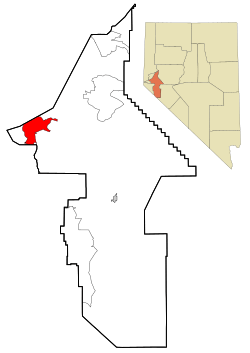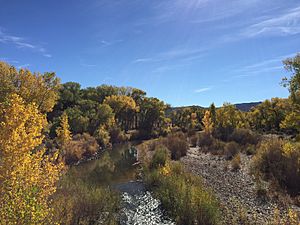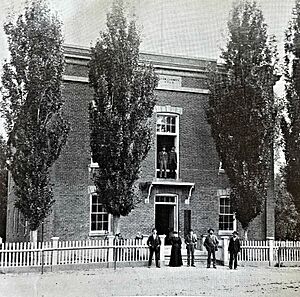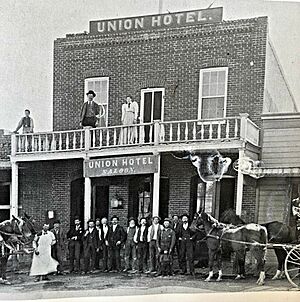Dayton, Nevada facts for kids
Quick facts for kids
Dayton, Nevada
|
|
|---|---|
 |
|

Location of Dayton, Nevada
|
|
| Country | United States |
| State | Nevada |
| County | Lyon |
| Area | |
| • Total | 34.91 sq mi (90.42 km2) |
| • Land | 34.90 sq mi (90.39 km2) |
| • Water | 0.01 sq mi (0.03 km2) |
| Elevation | 4,397 ft (1,340 m) |
| Population
(2020)
|
|
| • Total | 15,153 |
| • Density | 434.18/sq mi (167.64/km2) |
| Time zone | UTC-8 (Pacific (PST)) |
| • Summer (DST) | UTC-7 (PDT) |
| ZIP code |
89403
|
| Area code(s) | 775 |
| FIPS code | 32-17500 |
| GNIS feature ID | 0856226 |
| Reference #: | 7 |
Dayton is a community in Lyon County, Nevada, United States. It is a "census-designated place" (CDP), which means it's an area defined for counting people. In 2020, about 15,153 people lived there. Dayton is known as one of the oldest settlements in Nevada. It is also home to the oldest hotel in the state.
Contents
History of Dayton
Dayton is located by the Carson River. It is at the end of a long, dry stretch of land. Travelers often stopped here for water. They would think about which way to go next. Because of this, the area was first called "Ponderers Rest."
In 1849, a man named Abner Blackburn found a gold nugget nearby. This was in Gold Creek, which flows into the Carson River.
From Gold Rush to China Town
By 1850, gold miners settled at the mouth of Gold Cañon. They were looking for gold in the sand. At first, the settlement was simply called "Gold Cañon" or "Gold Cañon Flat." Throughout the 1850s, Dayton became an important place for miners. They came here for supplies and services.
In 1857, many Chinese miners moved to the area. They wanted to avoid mining taxes in California. In 1859, a huge silver discovery happened nearby. This was called the Comstock Lode. New towns like Gold Hill and Virginia City grew quickly. Most miners went there. By 1860, many Chinese miners lived in Dayton. The U.S. census called it "China Town" that year.
Soon, people realized they could make money by helping the miners. They provided milling services, goods, and other services. So, more people came to Dayton.
Dayton's Official Name and Growth
In 1861, the town officially became "Dayton." It was named after John Day, a local surveyor. He later became the Surveyor General of Nevada. On November 29, 1861, Dayton became the main government center for Lyon County.
Because of the water from the Carson River, Dayton became a major milling center for the Comstock Lode. It grew very fast. In 1860, only 78 people lived there. By 1865, the population was 2,500! Its courthouse, built in 1864, was one of the first in Nevada.
In 1866 and 1870, big fires damaged Dayton. These "Great Fires" made the town much smaller. In 1869, the Virginia and Truckee Railroad opened. This moved ore processing to another area. Dayton still served as a center for business and government, but it was quieter.
The Carson & Colorado Railroad arrived in 1881. This brought some new life to Dayton. However, the population stayed around 500 people until after World War I.
Changes and Modern Times
In 1909, a fire destroyed the Lyon County Courthouse. Another growing town, Yerington, wanted to be the county seat. In 1911, the county government moved to Yerington. This caused Dayton's economy and population to shrink.
By the 1920s, the Lincoln Highway brought some tourists to Dayton. But the town remained quiet. It was a reminder of Nevada's gold and silver rush days. Dayton did not reach its 1865 population of 2,500 again until 1930.
In 1961, Dayton became famous. It was a filming location for The Misfits. This movie starred Clark Gable and Marilyn Monroe. It was their last movie. Starting in the 1990s, Dayton grew a lot. Many new homes were built near the Carson River.
The old part of Dayton is now part of the Comstock Historic District. It has a nice main street and a local museum. The museum is in an old schoolhouse from 1865. This is the oldest schoolhouse in Nevada still in its original spot.
Oldest Settlement Debate
Dayton claims to be Nevada's oldest settlement. However, people in Genoa disagree. Dayton points to a pioneer's journal from 1849. It mentions over 200 miners already working in Gold Cañon (Dayton). It also notes that Genoa was founded later.
Genoa residents say their town had the first post office. They also had other town government features first. They believe this makes them "Nevada's first town." People in Dayton usually don't argue much about this claim.
Dayton is listed as Nevada Historical Marker 7.
Geography of Dayton
Dayton is located in western Lyon County. It is about 12 miles east of Carson City, the state capital. U.S. Route 50 goes through Dayton. This road leads east to Fallon and west to Carson City.
The Dayton area covers about 34.91 square miles (90.42 square kilometers). Most of this area is land. Only a tiny part is water.
Population Information
| Historical population | |||
|---|---|---|---|
| Census | Pop. | %± | |
| 1970 | 826 | — | |
| 1980 | 4,376 | 429.8% | |
| 2000 | 5,907 | — | |
| 2010 | 8,964 | 51.8% | |
| 2020 | 15,153 | 69.0% | |
| U.S. Decennial Census | |||
Dayton has grown a lot over the years. In 1970, about 826 people lived there. By 2020, the population had grown to 15,153 people.
Economy in Dayton
In 2012, many people in Dayton worked in retail stores. This means they worked in shops selling goods. The next biggest job areas were hotels and restaurants. Manufacturing also provided jobs.
Retail businesses brought in the most money for Dayton in 2012. Manufacturing was the second highest in sales.
Molossia
Dayton has seen a boost in tourism because of the Republic of Molossia. This is a very small "micronation" located nearby. A micronation is like a tiny, pretend country. Several events related to Molossia have happened in the area. Other micronations have also been founded, helping to bring more tourists to Dayton.
See also
 In Spanish: Dayton (Nevada) para niños
In Spanish: Dayton (Nevada) para niños




